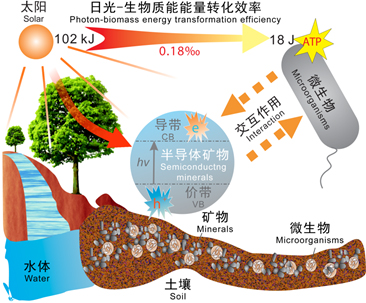Under the successive funding of two National 973 programs in the frontier area of key scientific research, we proposed the new theory that mineral photoelectrons are the third energy form on earth surface, and they can provide energy source for life origin and organic evolution. This theory is based on the already known cognition that solar photons and element valence electrons are the two fundamental energy forms. It further expands the traditional photosynthesis model by proposing a new model of solar energy absorption and utilization in geological processes on earth's surface.
The sustainable energy source in early earth's life origin has always been a problem that troubled the academic area. We have proposed that semiconducting mineral photoelectrons were generated under light excitation, and in early Earth, the ubiquitous semiconducting minerals of sulfides, strong sunlight and reducing environment benefited the generation and separation of photoelectrons. Photoelectrons with high energy could effectively reduce carbon dioxide in the atmosphere to small organic molecules, possibly providing basic matters for early life's origin, which was the first step of life's origin promoted by a non-biological pathway. According to the traditional theory, the energy source of microbial life activity is mainly from solar and chemical energy stored in chemicals. Correspondingly, phototrophy and chemotrophy are the basic two nutrition models for microbial growth and metabolism. By our studies, photoelectrons from natural semiconducting minerals could be transferred along the long electron transport chain between the minerals and microorganisms, finally to microorganisms, and significantly promoted the growth of some non-phototrophic microbes by one to three orders of magnitudes. Based on these results, we newly proposed a third microbial nutrition model- photoelectrophy. Recently, we discovered that in typical geological settings like surface soil, gobi, desert, rock desert and yellow soil, almost all rocks' surfaces were coated by several microns thick of Fe/Mn oxides "thin film". These Fe/Mn oxides are typical semiconducting minerals. The semiconducting mineral "thin film" in surface earth is the key mediator for solar energy absorption, transformation and utilization via an unconventional photosynthesis, which provided a novel perspective for understanding the geochemical processes in the earth’s new outermost sphere from micron-nano scales.

Figure 1 Promotion of non-phototrophic bacteria growth by semiconducting minerals photocatalysis under solar light in a natural soil system
The research findings about mineral photoelectrons energy were published in the journals of "Nature Communications" and "Elements". The National Natural Science Foundation of China and US National Science Foundation jointly organized a workshop emphasis on the topic of photoelectrons energy in Peking University on March 23-25, 2015. Prof. Anhuai Lu published a special issue as the first guest editor in the famous geological journal "Elements". He was also the first Asian scholar who edited a special issue as the first guest editor in this journal, and was invited to give a keynote in the meeting of "Elements: 10 Years Old". Besides, he was invited to give a plenary lecture on the topic of mineral photoelectrons in the 21th international general meeting of IMA. The international colleagues evaluated the results that "this is a surprising, and some will say monumental discovery with far-reaching implications", which "might change the traditional cognition of microbial activity, energy capturing and utilizing modes", and that "have important implications in understanding the origin of life on Earth, and also in the research for life in the Universe".